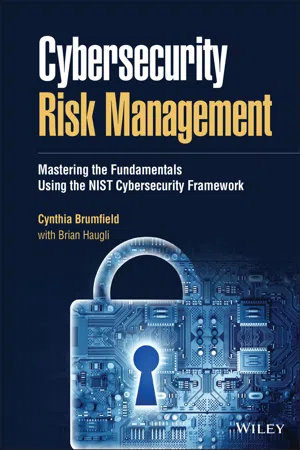
Cybersecurity Risk Management
Mastering the Fundamentals Using the NIST Cybersecurity Framework
- English
- ePUB (mobile friendly)
- Available on iOS & Android
Cybersecurity Risk Management
Mastering the Fundamentals Using the NIST Cybersecurity Framework
About this book
Cybersecurity Risk Management
In Cybersecurity Risk Management: Mastering the Fundamentals Using the NIST Cybersecurity Framework, veteran technology analyst Cynthia Brumfield, with contributions from cybersecurity expert Brian Haugli, delivers a straightforward and up-to-date exploration of the fundamentals of cybersecurity risk planning and management. The book offers readers easy-to-understand overviews of cybersecurity risk management principles, user, and network infrastructure planning, as well as the tools and techniques for detecting cyberattacks. The book also provides a roadmap to the development of a continuity of operations plan in the event of a cyberattack.
With incisive insights into the Framework for Improving Cybersecurity of Critical Infrastructure produced by the United States National Institute of Standards and Technology (NIST), Cybersecurity Risk Management presents the gold standard in practical guidance for the implementation of risk management best practices.
Filled with clear and easy-to-follow advice, this book also offers readers:
- A concise introduction to the principles of cybersecurity risk management and the steps necessary to manage digital risk to systems, assets, data, and capabilities
- A valuable exploration of modern tools that can improve an organization's network infrastructure protection
- A practical discussion of the challenges involved in detecting and responding to a cyberattack and the importance of continuous security monitoring
- A helpful examination of the recovery from cybersecurity incidents
Perfect for undergraduate and graduate students studying cybersecurity, Cybersecurity Risk Management is also an ideal resource for IT professionals working in private sector and government organizations worldwide who are considering implementing, or who may be required to implement, the NIST Framework at their organization.
Frequently asked questions
- Essential is ideal for learners and professionals who enjoy exploring a wide range of subjects. Access the Essential Library with 800,000+ trusted titles and best-sellers across business, personal growth, and the humanities. Includes unlimited reading time and Standard Read Aloud voice.
- Complete: Perfect for advanced learners and researchers needing full, unrestricted access. Unlock 1.4M+ books across hundreds of subjects, including academic and specialized titles. The Complete Plan also includes advanced features like Premium Read Aloud and Research Assistant.
Please note we cannot support devices running on iOS 13 and Android 7 or earlier. Learn more about using the app.
Information
Table of contents
- Cover
- Title page
- Copyright
- Dedication
- Academic Foreword
- Acknowledgments
- Preface – Overview of the NIST Framework
- CHAPTER 1 Cybersecurity Risk Planning and Management
- CHAPTER 2 User and Network Infrastructure Planning and Management
- CHAPTER 3 Tools and Techniques for Detecting Cyber Incidents
- CHAPTER 4 Developing a Continuity of Operations Plan
- CHAPTER 5 Supply Chain Risk Management
- CHAPTER 6 Manufacturing and Industrial Control Systems Security
- Appendix A: Helpful Advice for Small Organizations Seeking to Implement Some of the Book’s Recommendations
- Appendix B: Critical Security Controls Version 8.0 Mapped to NIST CSF v1.1
- Answers to Chapter Quizzes
- Index
- End User License Agreement